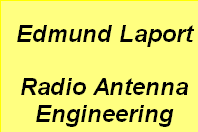|
To get another 30 per- cent on top of this, you'll
have to stuck four antennas. Therefore, with one antenna as the
reference (0 dB) two will gain 3 dB, four will gain 6 dB,
eight will gain 9- dB and so on. Since 6 dB is double voltage,
you need four antennas to get twice the voltage of one.
FICTION: As long as they aren't sensitive to the same channel, you can stack
antennas close on the same mast within interaction between them.
FACT: It's a myth. Any conductor placed in the field of a transmitting or
radiating device will intercept some of the energy of the field.
The conductor will re-radiate all of this energy except that part
dissipated in "copper losses," that is, due to the resistance
of the conductor. The coupling between these metallic elements
and the phase shifts caused by re-radiation will have many peculiar
effects.
The effects are worse when the conductors are spaced
apart less than a half-wavelength at the operation frequency of
either antenna. It does no good to argue that one antenna is at
right angles to the other since even in this condition, the boom
of one antenna is parallel to the other antenna. The boom picks
up, too. The same arguments apply to guy wires, which should never
run in front of, behind, or through the antennas.
FICTION: Since parallel-wire lead-in, such as 300-ohm ribbon, has only about
2 dB loss per hundred feet at the high channels, the lead loss
can be ignored unless the lead is over a hundred feet long.
FACT: The 2 dB /100 feet loss at 200 MHz is accurate figure- but only under
free- space, dry-air conditions. Any substance other than dry
air that comes in close contact with two lead increased its losses.
This includes dust, chemical deposits from smoke, carbon, water,
salt, stand-off insulators, feed through tubes in walls, and window
sills. Losses are apt to be, in actually, three or four times
the nominal cable-loss figure and the more cable involved, the
greater the loss.
It's an interesting experiment to connect the down-
lead from an antenna to a field- strength meter, and then grasp
the wire. A 6- dB drop is not unusual, which is a loss of half
the voltage. This loss is caused by absorption of energy contained
in the fields between and around the conductors of the twin-lead.
FICTION: Shielded twin-lead should be good for long leads in fringe areas, since
noise is so much more of a problem in fridge areas.
FACT: Shielded twin-lead has excellent capabilities for bringing signals through
areas of high ambient noise- but not where the signals are very
weak.
|
The presence of the metallic shield makes the loss
of this type cable higher than unshielded types. This loss can
rarely be tolerant in fringe areas.
FICTION: Coaxial lead should never be used for down-lead because of it has very high losses.
FACT: The nominal losses in twin-lead run between 2 and 2.7 dB/100 feet at
channel 13 (the worst VHF case) and are almost invariable higher
in actual use. The losses in RG-11/U coaxial cable are 3 dB/100
feet at channel 13, no matter how used. The new foam dielectric
cables have less loss the solid-dielectric types and can actually
show figures equal to twin lead. These latter cables may be taped
to masts, run through conduit, or buried without affecting their
loss characteristics adversely. They have been used to cure some
knotty problems in color reception caused by direct pickup on
twin-lead down-leads. However, one requirement must be met: the
antenna must be matched to the cable and the cable to the set
by means of matching transformers.
FICTION: You can always get better signals to the set by going higher with the
antenna.
FACT: The greatest increase of signal usually occurs in the first 40 feet
above the ground or when you clear surrounding obstacles. After
this, the increase is slow. On the other hand, as you go up, you
increase the length of the down lead. The increase of down-lead
losses quite frequently offsets the increase in signal! The net
result is that you may get more signal at the antenna, but not at the set. The only way to
get around this difficulty is with a mast- mounted preamplifier.
FICTION: When probing for signal in a fringe area, move the antenna up and down
until you get the strongest signal, then mount the antenna permanently
in the resultant position. This will always be the best place
for the antenna.
FACT: This will be the best place for the antenna at this time and for this
channel only. The fact is that this point of "best signal"
can change with the weather and the season.
The reason for the "hot-spot" is that some
refracted radiation is arriving at particular spot in phase with
some reflected radiation. The reflected radiation may be from
an upper-atmosphere boundary layer, which varies with weather
and sunlight, or from a ground reflection, which varies according
to the condition of vegetation or precipitation. You cannot depend
on these spots.
|












